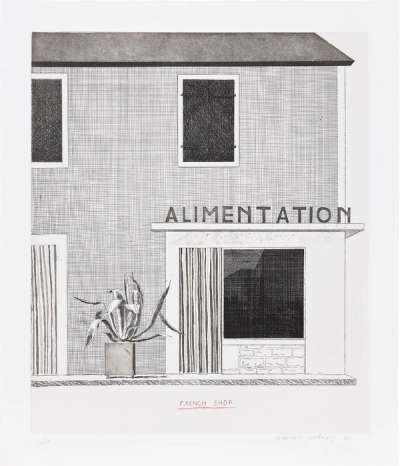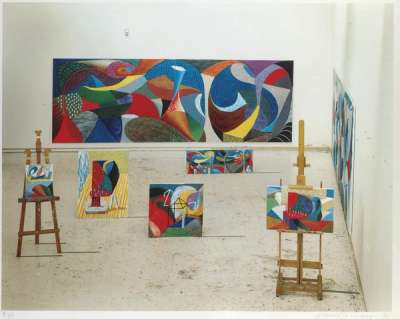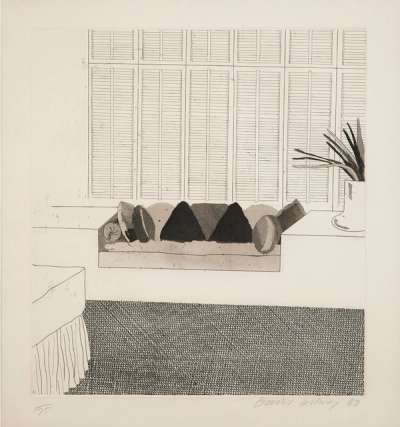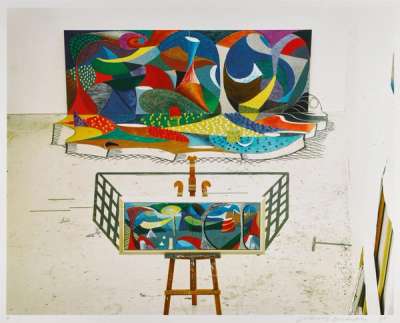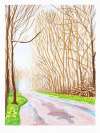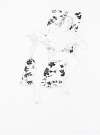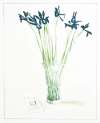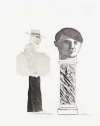Interiors
and Exteriors
Though David Hockney is best known for his portraits of friends and lovers, the supporting actor in all these intimate works is always the interior setting. In the following, we see these interiors stripped of sitters, their light and proportions becoming the focus as the artist lovingly renders objects and ornament.
David Hockney Interiors and Exteriors For sale
Interiors and Exteriors Value (5 Years)
With £223502 in the past 12 months, David Hockney's Interiors and Exteriors series is one of the most actively traded in the market. Prices have varied significantly – from £611 to £240718 – driven by fluctuations in factors like condition, provenance, and market timing. Over the past 12 months, the average selling price was £14900, with an average annual growth rate of -0.19% across the series.
Interiors and Exteriors Market value
Auction Results
| Artwork | Auction Date | Auction House | Return to Seller | Hammer Price | Buyer Paid |
|---|---|---|---|---|---|
 Rue De Seine David Hockney Signed Print | 9 Dec 2025 | Bonhams New Bond Street | £25,500 | £30,000 | £40,000 |
Views Of Hotel Well II | 6 Dec 2025 | Link Auction Galleries | £34,000 | £40,000 | £50,000 |
 French Shop David Hockney Signed Print | 26 Nov 2025 | Aspire Art Auctions, Johannesburg | £2,635 | £3,100 | £3,450 |
 Sofa 8501 Hedges Place David Hockney Signed Print | 19 Nov 2025 | Doyle Auctioneers & Appraisers | £3,995 | £4,700 | £6,500 |
 Cushions David Hockney Signed Print | 18 Sept 2025 | Phillips London | £5,950 | £7,000 | £9,500 |
 Mexican Hotel Garden David Hockney Signed Print | 17 Jul 2025 | Christie's New York | £5,525 | £6,500 | £9,000 |
Views Of Hotel Well III | 27 Apr 2024 | Mainichi Auction, Osaka | £42,500 | £50,000 | £60,000 |
Views Of Hotel Well I | 10 Jan 2024 | Lama | £34,000 | £40,000 | £50,000 |
Sell Your Art
with Us
with Us
Join Our Network of Collectors. Buy, Sell and Track Demand
Meaning & Analysis
While best known for his portraits and landscapes, Hockney’s Interiors and Exteriors shows his attention to detail when it comes to surroundings. This is an artist who knows the value of a well positioned chair or vase, the importance of a window or the drapery of a curtain to a composition. Some of Hockney's most masterful portraits are held together by his talent for recreating beautiful rooms.
With works such as Contrejour In The French Style and Home we see these interiors stripped of their sitters, their light and proportions taking centre stage as the artist lovingly reproduces object and ornament to charming effect. Whether it's a parquet floor, the slats of wooden shutters, the iron railings of a balcony or exquisitely detailed wallpaper, Hockney lavishes as much attention on these features as he would those of a sitter. Even when his interiors are more minimal, as in the case of Sofa 8501 Hedges Place we are treated to a devotion to light and shadow that infuses the work with hidden depth and recalls Durer’s classic studies of pillows.
Many of Hockney’s interiors are depicted from the perspective of one looking out from within and this is clearly seen in prints such as Mexican Hotel Garden and Views Of Hotel Well I where the artist appears to be sat under a kind of porch looking at an enclosed courtyard that we recognise from the series Moving Focus. Here the simplicity of the wooden structure is contrasted with the overflowing excess of the tropical plants. Overall there is a sense of generosity in the two works, thanks to the wide lens perspective that places the viewer directly in the artist’s shoes, looking out at the scene. With works such as Caribbean Tea Time Paravent, we see Hockney taking this blend of inside and outside further. Here he combines multiple viewpoints, as we have seen him do in his photo collages to create an almost Cubist effect, presenting us with tables and chairs, archways and plants as well as what could be a swimming pool or pond on the left hand side. As well as challenging the norms of composition here Hockney subverts tradition once again by presenting the print on a paravent, or screen, transforming the scene to become part of another interior entirely.
Hockney’s work also pays close attention to exterior architecture, whether through the low pastel coloured modernist buildings of LA or the looming skyscrapers of New York, as seen in A Rake’s Progress. In works such as French Shop we see him depicting a classically European building with its plain plaster facade in a very precise, almost illustrative, style. He incorporates the shop’s sign, evoking A Rake’s Progress again where lettering is combined with his talent for draughtsmanship to great effect.
